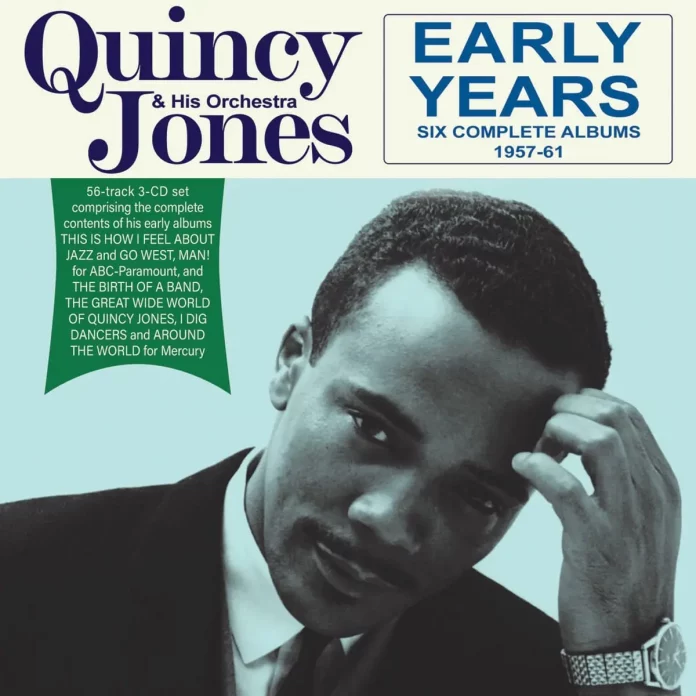The 1950s were a major era for composer and leaders. Quincy Jones, Manny Albam and Neal Hefti led the vital movement that succeeded the late 40s “death” of the big bands, and Basie’s new band became their main showcase.
With a pool of accomplished musicians available, Quincy’s recordings led the way; he produced the tracks on CD1 when he was only 23. These CDs cover the years when his driving force was jazz. In later years his universality broadened to include music that might be described as having more general appeal.
His musicians knew the value of Q’s great talent and most of them made sure they were always available, including the heart of the band – Harry Edison, Art Farmer, Jimmy Cleveland and Phil Woods. The devotion showed. The young Zoot Sims made the 400-mile round trip from Washington DC to New York just to solo on Stockholm Sweetnin’ (Quincy was careless with g). Clifford Brown’s solo from Quincy’s original version is scored here for the horns.
The first six tracks, from 1956, show Q’s glorious concept and the 11-minute Walkin’ is a perfect example of a jazz classic making every second count. Each soloist is comfortable and eloquent and all, beginning with Art Farmer, play with faultless imagination. Later there are magnificent conversations between the three trombones, and the ever inspired Phil Woods, given lots of space on these discs, confirms himself as the best post-Parker player on alto.
The music here came from Quincy’s soul, and he never bettered this soloist and ensemble combination. The easy discipline of his recordings came from familiarity and they set a new high standard for everyone else to conform to. The Birth Of A Band album, which came next, is here too and, with dazzling work from Clark Terry and Woods again, it rose to become the big band album for others to follow. Surely most people will already have these tracks in their collections. If not, pounce.
Discography
CD1: Walkin’; A Sleepin’ Bee; Sermonette; Stockholm Sweetnin’; Evening In Paris; Boo’s Blues; Dancin’ Pants; Blues Day; Bright Moon; No Bones At All; The Oom Is Blues; Be My Guest; Medley (69.55)
CD2: London Derriere; Kings Road Blues; The Birth Of A Band; Moanin’; I Remember Clifford; Along Came Betty; Tickle Toe; Happy Faces; Whisper Not; The Gypsy; A Change Of Pace; Tuxedo Junction; Lester Leaps In; Ghana; Caravan; Everybody’s Blues; Cherokee; Air Mail Special; They Say It’s Wonderful; Chant Of The Weed; I Never Has Seen Snow (72.54)
CD3: Eesom; Pleasingly Plump; G’Wan Train; Moonglow; Tone Poem; You Turned The Tables On Me; Chinese Chequers; Love Is Here To Stay; The Midnight Sun Will Never Set; Trouble On My Mind; A Sunday Kind Of Love; Hot Sake; Strike Up The Band; Africana; Meadowlands; Rico Vacilon; Under Paris Skies; Mack The Knife; Manolete De Espana; Baia; Come Back To Sorrento; Dear Old Stockholm (70.38)
Quincy Jones and his Orchestra, including:
CD1: Art Farmer (t); Jimmy Cleveland, Urbie Green, Frank Rehak (tb); Phil Woods, Benny Carter, Art Pepper (as); Zoot Sims, Bill Perkins (ts); Milt Jackson (vib). NYC, 1956-7.
CD2: Harry Edison, Conte Candoli, Jack Sheldon, Clark Terry, Joe Newman, Joe Wilder (t); Cleveland, Rehak, Green (tb); Woods, Carter, Herb Geller (as). NYC, 1957-9.
CD3: Benny Bailey, Terry (t); Curtis Fuller (tb); Woods (as); Oliver Nelson (ts); Les Spann (g, f). NYC, 1960-61.
Acrobat ACTRCD9127

